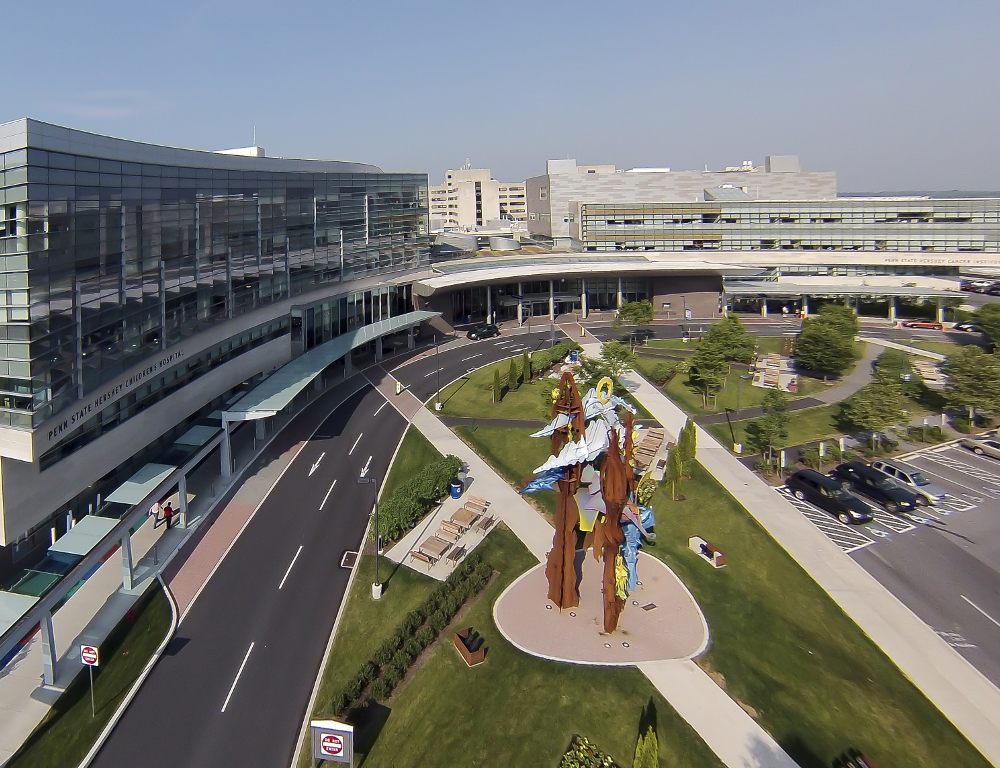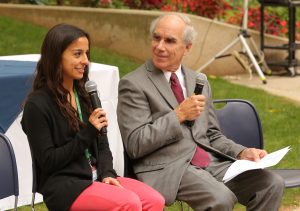Growth and innovation mark Medical Center and College of Medicine's 2016-17 fiscal year

The first year of medical school class photos that include Dr. Fred Michel and Sayeh Bozorghadad could not be more different: One is a black and white, “yearbook style” composite of individual head shots, showing the 34-member Penn State College of Medicine class of 1971—three women and no one of obvious minority status; the second is a full color, wide angle group shot of the 152-member class of 2021, of which 54 percent are women and 43 percent identified themselves as being from a minority background.
The two pictures tell just one important part of the amazing contrast between medical education and health care then and now. Michel ('71) and Bozorghadad told another part of that story during today's event to celebrate the 50th anniversary of the College of Medicine. They talked about the cost of medical education today and the need for more scholarship support to offset that cost; of the difference between a traditional curriculum and today's more personalized approaches; and the importance of a student body that matches the diverse backgrounds and experiences of the increasingly diverse communities they will serve.
In the hour that followed the 50th anniversary celebration, Dr. A. Craig Hillemeier, dean of Penn State College of Medicine, chief executive officer of the Penn State Health Milton S. Hershey Medical Center and Penn State's senior vice president for health affairs, shared highlights of the organization's 2016-2017 fiscal year performance with members of the Medical Center's Board of Directors, faculty, staff, students and others. Many of the highlights further demonstrate how the Milton S. Hershey Medical Center and Penn State College of Medicine are helping Penn State Health address today's health care challenges and opportunities through innovation.
Hillemeier noted some of the important commitments being made to enhance the health of central Pennsylvania communities through research as well as to educate the medical care providers and researchers of tomorrow.
Medical Center and College of Medicine researchers earned more than $100 million in external research funding in fiscal year 2017. This money supports efforts of faculty and staff to do meaningful scientific studies into the causes, treatments, cures and prevention of disease. Examples of the lifesaving research underway supported by those dollars include:
- A new imaging technique called cryo-electron microscopy, which revealed never-before-seen details of the HPV virus that causes various types of cancer. This research may lead to better vaccines and HPV anti-viral medications.
- Research showing that e-cigarettes are less addictive than traditional cigarettes. Next, researchers will explore whether they lead to traditional cigarette use.
In August 2016, the organization launched the Center for Medical Innovation, which helps the College position itself as a nationally recognized academic medical center for commercialization and translational research. The center has resulted in 10 new patents, two start-up companies, three license agreements and the addition of 47 new medical technologies to Penn State's intellectual property portfolio.
When Michel enrolled at the College of Medicine in 1967, the curriculum followed the traditional medical education model of two years of anatomy and lecture followed by two years of clinical rotation primarily in a hospital setting. Bozorghadad and her peers are enrolled in another curriculum altogether, where their classroom and “real world” learning are blended across all years of training: They have guided learning opportunities with patients from their first days in training, often in settings outside the hospital, such as outpatient practice sites, community health care settings or even a patient's home.
The College of Medicine is a recognized national leader in driving health care and health sciences education, including:
- Implementation of a full, four-year curriculum at University Park, developed by student design partners.
- New longitudinal integrated clerkships that offer students unique opportunities to learn in a variety of contemporary health care settings.
- A range of joint degree offerings, including MD/PhD, MD/MPH and MD/MBA, with plans to launch an MD/MEd program soon.
- Accelerated degree programs in four disciplines: Family and Community Medicine, Emergency Medicine, Neurosurgery and Orthopedics.
- A joint MD/MPH degree program and DrPH program that enrolled their first students last fall
These programs will be further supported by construction of the Innovation Pavilion, a modern addition to the original Medical Center and College of Medicine buildings designed to better integrate research and education by fostering greater collaboration, supporting an innovative education model of team-based learning and providing the infrastructure necessary to power new breakthroughs in science. The project will be among the most significant capital investments at any Penn State campus and provide nearly 300,000 square feet of more flexible training space, new research labs, and shared research equipment and systems that will lower costs by avoiding duplication and encourage greater collaboration.
The organization is seeking Penn State Board of Trustees approval of the project's architect on Friday (Sept. 15).
Patient care
Another significant change in health care since the College of Medicine's inaugural class earned its degrees is the heightened focus on outcomes of care beyond sheer volume. The Medical Center has enacted several measures in recent years to improve quality and safety. These are areas where the organization is always seeking to improve, and continued focus and commitment in the past year has demonstrated better overall outcomes and higher patient satisfaction, as well as recognition of those programs, including:
- U.S. News and World Report 2017 “Best Hospitals” rankings in four specialties for Penn State Health Children’s Hospital and two specialties for the Medical Center.
- A third consecutive designation as a Magnet hospital, the highest national honor for nursing excellence.
- Another prestigious three-star rating from the Society of Thoracic Surgeons for the congenital heart surgery program at Penn State Health Children’s Hospital.
While learning about the modern physical venues where care happens is important for today's medical learners, so is the fact that technology is being used in new ways every day to enhance and enable better care at greater convenience for patients. The past year has been marked by enhanced access to the Medical Center's services in innovative ways that don't always require travel. The organization has grown a robust and evolving telemedicine program, which allows:
- Stroke patients at our 16 LionNet affiliate hospitals to receive timely care and, in most cases, remain in their community.
- Patients with advanced amyotrophic lateral sclerosis (ALS) to consult with medical specialists without having to leave home.
- Community primary care providers to consult Hershey Medical Center dermatologists on skin problems from acne to melanoma.
- Emergency Department patients with mental health needs to be seen quickly by a Penn State Health psychiatrist.
- Patients in intensive care units (ICUs) at Hershey and partner sites to benefit from additional level “virtual” monitoring of vital signs and other indicators of health status through an e-ICU partnership with Mercy Virtual
Hillemeier highlighted some of the recent steps the organization has taken to help patients succeed after their hospital stay, including the Rx2Go program. The program offers patients who are being discharged to home the opportunity to have their prescriptions delivered to their hospital room, at which time they receive education from a pharmacist. Rx2Go helps reduce the risk of a patient not having important prescriptions filled or not taking them correctly, leading to unnecessary and costly readmissions to the hospital.
During fiscal year 2017, Hershey Medical Center outpatient visits increased to more than 1.1 million. The Medical Center saw more than 33,000 surgical cases, up 3 percent from fiscal year 2016. Overall admissions rose by 2 percent, to more than 29,000. The organization finished the year with a total margin of 9.2 percent, and provided more than $70 million to support the academic mission of the College of Medicine.
As Penn State Health pursues partnerships with other health care providers in the region to ensure no one must travel to Philadelphia, Pittsburgh or Baltimore to gain access to the high-quality care they need, investments in expansion of or additions to the at-capacity clinical facilities on the Hershey Medical Center campus are underway.
An expansion of Penn State Health Children’s Hospital will result in the addition of three final floors that were part of the building's original design. The additional floors would enable a move of the neonatal intensive care unit (NICU) and women's health services into the Children's Hospital, which would then allow the organization to use the vacated space in the adult hospital for other services.
A significant expansion of the Medical Center's Emergency Department is expected to start in October following Board of Trustees review and approval this week of the $29 million price tag.
If you're having trouble accessing this content, or would like it in another format, please email Penn State Health Marketing & Communications.

